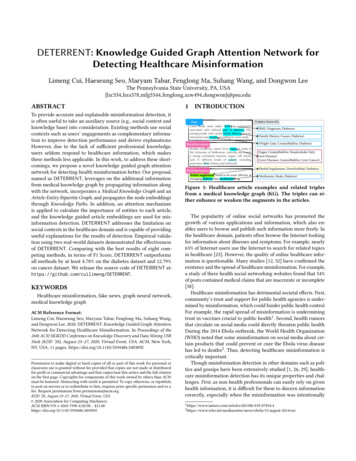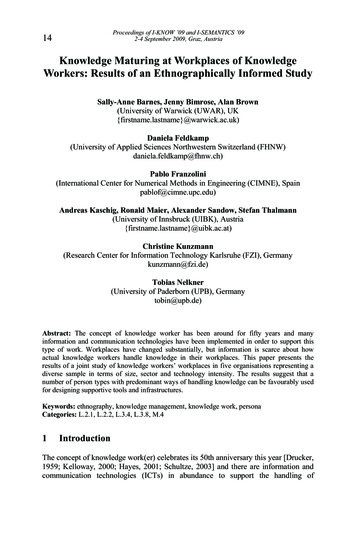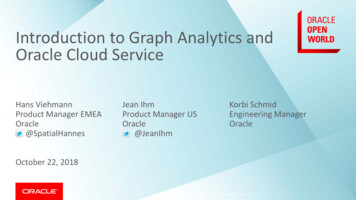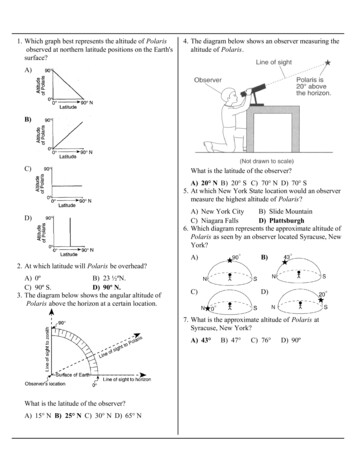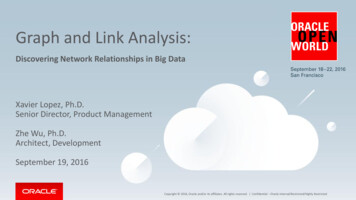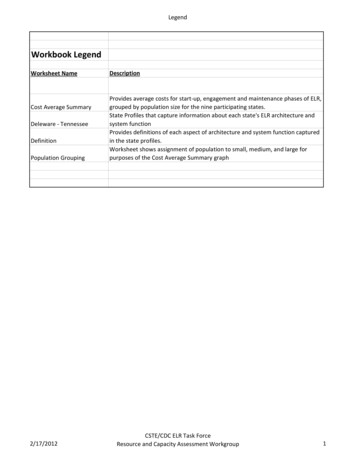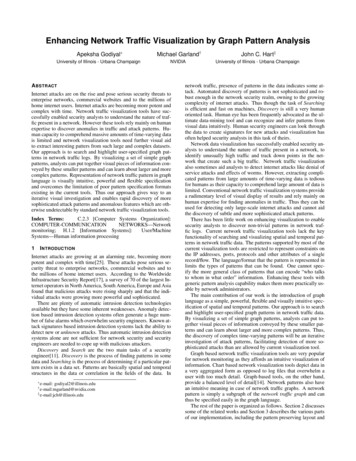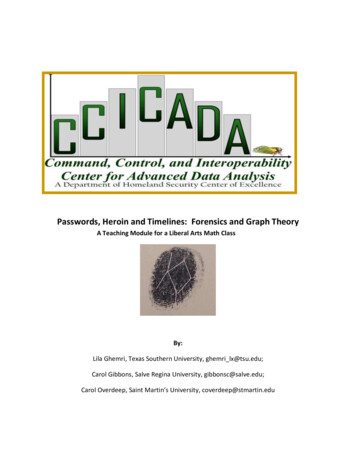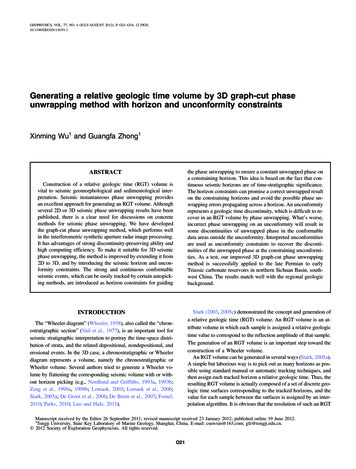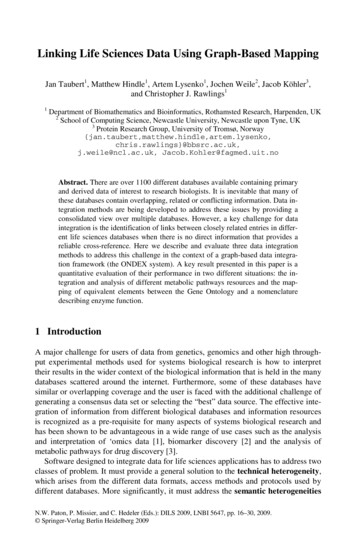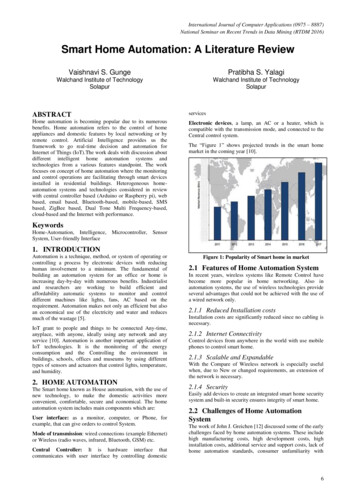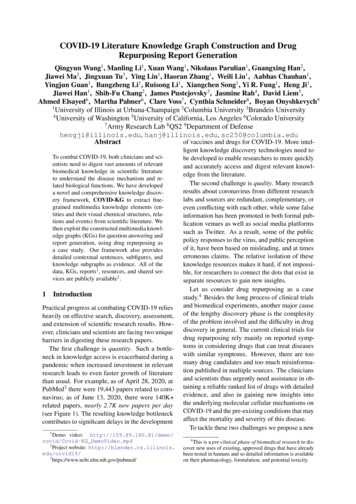
Transcription
COVID-19 Literature Knowledge Graph Construction and DrugRepurposing Report GenerationQingyun Wang1 , Manling Li1 , Xuan Wang1 , Nikolaus Parulian1 , Guangxing Han2 ,Jiawei Ma2 , Jingxuan Tu3 , Ying Lin1 , Haoran Zhang1 , Weili Liu1 , Aabhas Chauhan1 ,Yingjun Guan1 , Bangzheng Li1 , Ruisong Li1 , Xiangchen Song1 , Yi R. Fung1 , Heng Ji1 ,Jiawei Han1 , Shih-Fu Chang2 , James Pustejovsky3 , Jasmine Rah4 , David Liem5 ,Ahmed Elsayed6 , Martha Palmer6 , Clare Voss7 , Cynthia Schneider8 , Boyan Onyshkevych91University of Illinois at Urbana-Champaign 2 Columbia University 3 Brandeis University4University of Washington 5 University of California, Los Angeles 6 Colorado University7Army Research Lab 8 QS2 9 Department of Defensehengji@illinois.edu, hanj@illinois.edu, sc250@columbia.eduAbstractof vaccines and drugs for COVID-19. More intelTo combat COVID-19, both clinicians and scientists need to digest vast amounts of relevantbiomedical knowledge in scientific literatureto understand the disease mechanism and related biological functions. We have developeda novel and comprehensive knowledge discovery framework, COVID-KG to extract finegrained multimedia knowledge elements (entities and their visual chemical structures, relations and events) from scientific literature. Wethen exploit the constructed multimedia knowledge graphs (KGs) for question answering andreport generation, using drug repurposing asa case study. Our framework also providesdetailed contextual sentences, subfigures, andknowledge subgraphs as evidence. All of thedata, KGs, reports1 , resources, and shared services are publicly available2 .1IntroductionPractical progress at combating COVID-19 reliesheavily on effective search, discovery, assessment,and extension of scientific research results. However, clinicians and scientists are facing two uniquebarriers in digesting these research papers.The first challenge is quantity. Such a bottleneck in knowledge access is exacerbated during apandemic when increased investment in relevantresearch leads to even faster growth of literaturethan usual. For example, as of April 28, 2020, atPubMed3 there were 19,443 papers related to coronavirus; as of June 13, 2020, there were 140K related papers, nearly 2.7K new papers per day(see Figure 1). The resulting knowledge bottleneckcontributes to significant delays in the development1Demo video: http://159.89.180.81/demo/covid/Covid-KG DemoVideo.mp42Project website: w.ncbi.nlm.nih.gov/pubmed/ligent knowledge discovery technologies need tobe developed to enable researchers to more quicklyand accurately access and digest relevant knowledge from the literature.The second challenge is quality. Many researchresults about coronavirus from different researchlabs and sources are redundant, complementary, oreven conflicting with each other, while some falseinformation has been promoted in both formal publication venues as well as social media platformssuch as Twitter. As a result, some of the publicpolicy responses to the virus, and public perceptionof it, have been based on misleading, and at timeserroneous claims. The relative isolation of theseknowledge resources makes it hard, if not impossible, for researchers to connect the dots that exist inseparate resources to gain new insights.Let us consider drug repurposing as a casestudy.4 Besides the long process of clinical trialsand biomedical experiments, another major causeof the lengthy discovery phase is the complexityof the problem involved and the difficulty in drugdiscovery in general. The current clinical trials fordrug repurposing rely mainly on reported symptoms in considering drugs that can treat diseaseswith similar symptoms. However, there are toomany drug candidates and too much misinformation published in multiple sources. The cliniciansand scientists thus urgently need assistance in obtaining a reliable ranked list of drugs with detailedevidence, and also in gaining new insights intothe underlying molecular cellular mechanisms onCOVID-19 and the pre-existing conditions that mayaffect the mortality and severity of this disease.To tackle these two challenges we propose a new4This is a pre-clinical phase of biomedical research to discover new uses of existing, approved drugs that have alreadybeen tested in humans and so detailed information is availableon their pharmacology, formulation, and potential toxicity.
framework, COVID-KG, to accelerate scientificdiscovery and build a bridge between the researchscientists making use of our framework and clinicians who will ultimately conduct the tests, asillustrated in Figure 2. COVID-KG starts by reading existing papers to build multimedia knowledgegraphs (KGs), in which nodes are entities/conceptsand edges represent relations and events involvingthese entities, as extracted from both text and images. Given the KGs enriched with path rankingand evidence mining, COVID-KG answers naturallanguage questions effectively. With drug repurposing as a case study, we focus on 11 typicalquestions that human experts pose and integrateour techniques to generate a comprehensive reportfor each candidate 05-2805-2105-1405-0704-3020000Figure 1: Increasing numbers of COVID-19 papersover time in PubMed website22.1Multimedia Knowledge GraphConstructionCoarse-grained Text KnowledgeExtractionOur coarse-grained Information Extraction (IE)system consists of three components: (1) coarsegrained entity extraction (Wang et al., 2019a) andentity linking (Zheng et al., 2015) for four entity types: Gene nodes, Disease nodes, Chemical nodes, and Organism. We follow the entityontology defined in the Comparative Toxicogenomics Database (CTD) (Davis et al., 2016), andobtain a Medical Subject Headings (MeSH) UniqueID for each mention. (2) Based on the MeSHUnique IDs, we further link all entities to theCTD and extract 133 subtypes of relations such asGene–Chemical–Interaction Relationships, Chemical–Disease Associations, Gene–Disease Associa-tions, Chemical–GO Enrichment Associations andChemical–Pathway Enrichment Associations. (3)Event extraction (Li et al., 2019): we extract 13Event types and the roles of entities involved inthese events as defined in (Nédellec et al., 2013),including Gene expression, Transcription, Localization, Protein catabolism, Binding, Protein modification, Phosphorylation, Ubiquitination, Acetylation, Deacetylation, Regulation, Positive regulation,and Negative regulation. Figure 3 shows an example of the constructed KG from multiple papers.Experiments on 186 documents with 12,916 sentences manually annotated by domain experts showthat our method achieves 83.6% F-score on nodeextraction and 78.1% F-score on link extraction.2.2Fine-grained Text Entity ExtractionHowever, questions from experts often involve finegrained knowledge elements, such as “Which animo acids in glycoprotein are most related to Glycan (CHEMICAL)?”. To answer these questions,we apply our fine-grained entity extraction systemCORD-NER (Wang et al., 2020c) to extract 75types of entities to enrich the KG, including manyCOVID-19 specific new entity types (e.g., coronaviruses, viral proteins, evolution, materials, substrates, and immune responses). CORD-NER relies on distantly- and weakly-supervised methods(Wang et al., 2019b; Shang et al., 2018), with noneed for expensive human annotation. Its entity annotation quality surpasses SciSpacy (up to 93.95%F-score, over 10% higher on the F1 score basedon a sample set of documents), a fully supervisedBioNER tool. See Figure 4 for results on part of aCOVID-19 paper (Zhang et al., 2020).2.3Image Processing and Cross-mediaEntity GroundingFigures in biomedical papers may contain different types of visual information, for example, displaying molecular structures, microscopic images,dosage response curves, relational diagrams, andother unique visual content. We have developeda visual IE subsystem to extract the visual information from figures to enrich the KG. We start bydesigning a pipeline and automatic tools shownin Figure 5 to extract figures from papers in theCORD-19 dataset and segment figures into nearlyhalf a million isolated subfigures. In the end, weperform cross-modal entity grounding, i.e., associating visual objects identified in these subfigureswith entities mentioned in their captions or refer-
Figure 2: COVID-KG Overview: From Data to Semantics to KnowledgeFigure 5: System Pipeline for Automatic Figure Extraction and Subfigure Segmentation. The figure imageshown here is from (Kizziah et al., 2020)Figure 3: Constructed KG Connecting Losartan (candidate drug in COVID-19) and cathepsin L pseudogene2 (gene related to coronavirus), where red nodes represent chemicals, grey nodes represents genes, and ualizationAngiotensin-converting enzyme 2 GENE OR GENOME ( ACE2 GENE OR GENOME ) as aSARS-CoV-2 CORONAVIRUS receptor: molecular mechanisms and potential therapeutic target.SARS-CoV-2 CORONAVIRUS has been sequenced [3]. A phylogenetic EVOLUTION analysis[3, 4] found a bat WILDLIFE origin for the SARS-CoV-2 CORONAVIRUS. There is a diversity ofpossible intermediate hosts for SARS-CoV-2 CORONAVIRUS, including pangolins WILDLIFE,but not mice EUKARYOTE and rats EUKARYOTE [5]. There are many similarities of SARSCoV-2 CORONAVIRUS with the original SARS-CoV CORONAVIRUS. Using computermodeling, Xu et al. [6] found that the spike proteins GENE OR GENOME of SARS-CoV-2CORONAVIRUS and SARS-CoV CORONAVIRUS have almost identical 3-D structures in thereceptor binding domain that maintains Van der Waals forces PHYSICAL SCIENCE. SARSCoV spike proteins GENE OR GENOME has a strong binding affinity to human ACE2GENE OR GENOME, based on biochemical interaction studies and crystal structure analysis[7]. SARS-CoV-2 CORONAVIRUS and SARS-CoV spike proteins GENE OR GENOME shareidentity in amino acid sequences and Figure 4: Example of Fine-grained Entity Extractionring text. To start, since most figures are embeddedas part of PDF files, we run Deepfigures (Siegelet al., 2018) to automatically detect and extract figures from each PDF document. Then each figureis associated with text in its caption or referringcontext (main body text referring to the figure). Inthis way, a figure can be attached, at a coarse level,to a KG entity if that entity is mentioned in theassociated text.To further delineate semantic and visual information contained within each subfigure, we have developed a pipeline to segment individual subfiguresand then align each subfigure with its corresponding subcaption. We run Figure-separator (Tsutsuiand Crandall, 2017) to detect and separate all nonoverlapping image regions. On occasion, subfigures within a figure may also be marked with alphabetical letters (e.g., A, B, C, etc). We use deep neural networks (Zhou et al., 2017) to detect text withinfigures and then apply OCR tools (Smith, 2007) toautomatically recognize text content within eachfigure. To identify subfigure marker text and textlabels for analyzing figure content, we rely on thedistance between text labels and subfigures to locate subfigure text markers. Location informationof such text markers can also be used to mergemultiple image regions into a single subfigure. In
dices. Each Kibana dashboard has a collectionof visualizations that are designed to interact witheach other. Dashboards are implemented as web applications. The navigation of a dashboard is mainlythrough clicking and searching. By clicking theprotein keyword EIF2AK2 in the tag cloud named“Enzyme proteins participating Modification relations”, a constraint on the type of proteins in modifications is added. Correspondingly, all the othervisualizationswill be changed.Figure 6: Expanding KG through Subfigure Segmentation and Cross-modal Entity Grounding. The figureOne unique feature of the semantic visualizaimage shown here is from (Ekins and Coffee, 2015)tion is the creation of dense tag clouds and denseheatmaps, through a process of parameter reduction over relations, allowing for the visualization ofthe end, each subfigure is segmented, and associrelation sets as tag clouds and multiple chained relaated with its corresponding subcaption and refertions as heatmaps. Figure 7 illustrates such a densering context. The segmented subfigures and asheatmap that contains relations between proteinssociated text labels provide rich information thatand implicated diseases (e.g., “those proteins thatcan expand the KG constructed from text captions.are down-regulators of TNF which are implicatedFor example, as shown in Figure 6, we apply ain obesity”), along with their type information7 .classifier to detect subfigures containing molecularstructures. Then by linking the specific drug namesextracted from within-figure text to correspondingdrug entities in the coarse KG constructed fromthe caption text, an expanded cross-modal KG canbe constructed that then links images with specificmolecular structures to their drug entities in theKG.2.4Knowledge Graph SemanticVisualizationIn order to enhance the exploration and discoveryof the information mined from the COVID-19 literature through the algorithms discussed in previoussections, we create semantic visualizations overlarge complex networks of biomedical relations using the techniques proposed by Tu et al. (2020).Semantic visualization allows for the visualizationof user-defined subsets of these relations interactively through semantically typed tag clouds andheat maps. This allows researchers to get a globalview of selected relation subtypes drawn from hundreds or thousands of papers at a single glance.This in turn allows for the ready identification ofnovel relations that would typically be missed bydirected keyword searches or simple unigram wordcloud or heatmap displays.5We first build a data index from the knowledgeelements in the constructed KGs, and then createa Kibana dashboard6 out of the generated data in-Figure 7: Regulatory Processes-Disease InteractionsHeatmap3Knowledge-driven QuestionAnsweringIn contrast to most current question-answering(QA) methods which target single documents, wehave developed a QA component based on a combination of KG matching and distributional semanticmatching across documents. We build KG indexingand searching functions to facilitate effective astic/kibanaWe use the following symbols to indicate the “action”involved in each protein: “ ” increase, “ ” decrease,“ ” affect.
efficient search when users pose their questions.We also support extended semantic matching fromthe constructed KGs and related texts by acceptingmulti-hop queries.A common category of queries is the connections between two entities. Given two entities ina query, we generate a subgraph covering salientpaths between them to show how they are connected through other entities. Figure 3 is an example subgraph summarizing the connections betweenLosartan and cathepsin L pseudogene 2. The pathsare generated by traversing the constructed KG,and are ranked by the number of papers coveringthe knowledge elements in each path in the KG.Each edge is assigned a salience score by aggregating the scores of paths passing through it. Inaddition to knowledge elements, we also present related sentences and source information as evidence.We use BioBert (Lee et al., 2020), a pre-trainedlanguage model to represent each sentence alongwith its left and right neighboring sentences as local contexts. Using the same architecture computedon all respective sentences and the user query, weaggregate the sequence embedding layer, the lasthidden layer in the BERT architecture with averagepooling (Reimers and Gurevych, 2019). We use thesimilarity between the embedding representationsof each sentence and each query to identify andextract the most relevant sentences as evidence.Another common category of queries includesentity types, rather than entity instances, and requires extracting evidence sentences based on typeor pattern matching. We have developed E VI DENCE M INER (Wang et al., 2020a,b), a web-basedsystem that allows for the user’s query as a naturallanguage statement or an inquiry about a relationship at the meta-symbol level (e.g., CHEMICAL,PROTEIN) and then automatically retrieves textualevidence from a background corpora of COVID-19.44.1A case study on Drug RepurposingReport GenerationTask and DataA human-written report about drug repurposingusually answers the following typical questions.1. Current indication: what is the drug class?What is it currently approved to treat?2. Molecular structure (symbols desired, but apointer to a reference is also useful)3. Mechanism of action i.e., inhibits viral entry,replication, etc. (w/ a pointer to data)4. Was the drug identified by manual or computation screen?5. Who is studying the drug? (Source/lab name)6. In vitro Data available (cell line used, assaysrun, viral strain used, cytopathic effects, toxicity, LD50, dosage response curve, etc.)7. Animal Data Available (what animal model,LD50, dosage response curve, etc.)8. Clinical trials on going (what phase, facility,target population, dosing, intervention etc.)9. Funding source10. Has the drug shown evidence of systemic toxicity?11. List of relevant sources to pull data from.The answers to questions #5 and #11 are extracted based on the meta-data sections of research papers in scientific literature, including theauthor affiliation and acknowledgement sections.The answers for other questions are all extractedbased on the knowledge graphs constructed andknowledge-driven question-answering method described above.As in our case studies, DARPA biologists inquired about three drugs, Benazepril, Losartan, andAmodiaquine, and their links to COVID-19 relatedchemicals/genes as shown in Figure 8:BM1 00870 BM1 06175 BM1 16375 BM1 17125 BM1 22385 BM1 30360BM1 33735 BM1 56245 BM1 56735 BM1 00870 BM1 06175 BM1 16375BM1 17125 BM1 22385 BM1 30360 BM1 33735 BM1 56245 BM1 56735CATB-10270 CATB-1418 CATB-1674 CATB-16A CATB-16D2 CATB-1852 CATB1874 CATB-2744 CATB-3098 CATB-348 CATB-3483 CATB-5880 CATB-84 CATB912 CATD CATHY CATK CATL CATL-LIKE CTS12 CTS3 CTS6 CTS7 CTS7-PS CTS8CTS8L1 CTS8-PS CTSA CTSA.L CTSB CTSBA CTSBB CTSB.L CTSB-PS CTSB.SCTSC CTSC.L CTSC.S CTSD CTSD2 CTSD.S CTSE CTSEAL CTSE.L CTSE.S CTSFCTSF.L CTSG CTSH CTSH.L CTSH-PS CTSJ CTSK CTSK1 CTSK.L CTSL CTSL.1CTSL3 CTSL3P CTSLA CTSLB CTSLL CTSL.L CTSLL3 CTSLP1 CTSLP2 CTSLP3CTSLP4 CTSLP6 CTSLP8 CTSM CTSM-PS CTSM-PS2 CTSO CTSO.L CTSQCTSQL2 CTSR CTSS CTSS1 CTSS.2 CTSS2.1 CTSS2.2 CTSSL CTSS.L CTSS.S CTSVCTSV.L CTSW CTSW.L CTSZ CTSZ.L CTSZ.S LOAG 18685 SMP 013040.1SMP 034410.1 SMP 067050 SMP 067060 SMP 085010 SMP 085180SMP 103610 SMP 105370 SMP 158410 SMP 158420 SMP 179950TSP 01409 TSP 02382 TSP 02383 TSP 03306 TSP 07747 TSP 10129TSP 10493 TSP 11596 LMAN1 LMAN1L LMAN1.L LMAN1.S LMAN2 LMAN2LMBL1P MBL2 ACE2 FURIN TMPRSS2Figure 8: COVID-19 related chemicals/genes.Our KG results for many other drugs are visualized at our website8 . We download new COVID-19papers from three Application Programming Interfaces (APIs): NCBI PMC API, NCBI Pubtator API,and CORD-19 archive. We provide incremental updates including new papers, removed papers andupdated papers, and their metadata information atour website9 tion.html9http://blender.cs.illinois.edu/covid19/
4.2QuestionResultsAs of June 14, 2020 we collected 140K papers.We selected 25,534 peer-reviewed papers and constructed the KG that includes 7,230 Diseases,9,123 Chemicals and 50,864 Genes, with 1,725,518Chemical-Gene links, 5,556,670 Chemical-Diseaselinks, and 7,7844,574 Gene-Disease links. TheKG has received more than 1,000 downloads.Our final generated reports10 are shared publicly.For each question, our framework provides answers along with detailed evidence, knowledge subgraphs, image segmentation and analysis
report generation, using drug repurposing as a case study. Our framework also provides detailed contextual sentences, subfigures, and knowledge subgraphs as evidence. All of the data, KGs, reports1, resources, and shared ser-vices are pu
